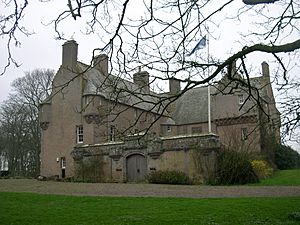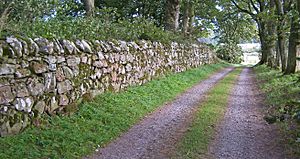Muchalls Castle facts for kids
Quick facts for kids Muchalls Castle |
|
|---|---|
| Aberdeenshire, Scotland | |

Muchalls Castle
|
|
| Site information | |
| Open to the public |
No |
| Condition | In use |
| Site history | |
| Built | 1300 |
| Built by | Frasers of Muchalls |
| In use | Present |
| Materials | Stone |
Muchalls Castle is a cool old castle in Aberdeenshire, Scotland. It sits high up, looking out over the North Sea. The oldest part of the castle is a strong, stone tower house from the 13th century. The Frasers of Muchalls built this first section.
Later, in the 17th century, the Burnetts of Leys added more to the castle. They built the rest of the four-story castle you see today. It was finished in 1627 by Sir Thomas Burnett, 1st Baronet.
Muchalls Castle is special because of its design. It's built in an "L" shape, which was a popular style for castles back then. A famous historian, Nigel Tranter, says it's one of the most interesting castles in northeast Scotland.
The castle also has amazing plasterwork ceilings. These were made in 1624 and are still in great shape! They show family symbols (heraldry) of the Burnett family. You can also see symbols of their friends and pictures from the Bible. In the Great Hall, the fireplace has a special design above it. It shows the symbols of King James VI with ancient Egyptian-style figures.
Contents
What's Inside Muchalls Castle?
The Oldest Parts: Medieval Origins
The very bottom part of Muchalls Castle is from the 14th century. This was the original Clan Fraser tower house. On this level, you would find a dungeon, a guard room, and storage areas. There was also a room for visitors waiting to see the Laird (the castle's owner).
The medieval kitchen is also on this level. Its wall is super thick, over five meters! This thick wall hides a secret staircase. The kitchen still has its original stone floor from the 14th century. It also has a huge fireplace you can walk into. Inside this fireplace, there's another secret spiral staircase. Servants used this staircase to carry food upstairs. This was because servants weren't allowed to use the main stairs with the nobles.
The dungeon is interesting because it has a tiny window. You can still see the big steel hinges where the dungeon door would have been.
Newer Additions: The 17th Century Castle
The next floor up was built on top of the old medieval parts. Outside, you can see cool stone towers called turrets. There are also huge chimneys. The entrance courtyard has two sets of three gun loops. These were small holes for guns to defend the castle.
Inside, some bedrooms have circular nooks from the turrets. These nooks have small windows for looking out. Many original arrow slits are still there, showing how the castle was defended. Some of these slits go through walls that are over a meter thick!
The castle also has special "crow-stepped" gables. These are the stepped parts of the roofline, often found with large chimneys. Muchalls Castle is a very important historical building. There are also three other old buildings on the castle grounds, including a stone stables and a 17th-century dovecote (a building for pigeons).
Main Rooms and Secret Passages
The next floor has the main reception rooms. These include the Great Hall, the Ladies' Drawing Room, and the Gentlemen's Study. These rooms have the amazing 17th-century plasterwork ceilings. They are covered with family symbols, biblical figures, and other historical designs.
The fireplace in the Great Hall has a special plaster design above it. It shows Egyptian-style figures and the King James Arms. You can actually stand up inside this fireplace! It even has built-in bench seating. The fireplace also hides the "Laird's Lug." This was a secret listening system. It allowed the Laird to secretly hear conversations happening in the Great Hall from his room above.
Bedrooms and Later Changes
The top floor has several bedrooms. These include the Laird's Bedroom, the Priest's Bedroom, and the Queen's Bedroom. The Queen's Bedroom was very fancy, just in case a queen ever visited! She even had a "Winter Bedroom" for cold weather.
Each bedroom has its own fireplace. Some bathrooms also have fireplaces. The bathrooms themselves were added later, during the Victorian era. They used to be dressing rooms in the 17th century.
Many generations of the Burnett family lived in Muchalls Castle. Later, important people like James Robertson, Baron Robertson (a Scottish judge) lived there.
Muchalls Castle and the Covenanters
Muchalls Castle played a big part in a major event in Scottish history called the Reformation. In 1638, many Scots signed a special agreement called a Covenant. They were against the King trying to force a new church system on them.
The city of Aberdeen was one of the last places to agree to this Covenant. Six scholars from Aberdeen colleges, known as the "Aberdeen doctors," were against it. Sir Thomas Burnett, 1st Baronet, the owner of Muchalls Castle, was part of a group called the Covenanters. They went to Aberdeen to talk to the doctors.
The doctors offered the Covenanters a big feast. But the Covenanters refused to eat! They said they wouldn't meet until the doctors signed the Covenant. The doctors were upset and sent a list of questions to the Covenanters.
Muchalls Castle was where the Covenanters met to write their strong and clever answer to the doctors. Because of this meeting and other events, King Charles I made big changes. He agreed to many of the Covenanters' demands. This was a very important moment in Scottish history.
The Castle's Surroundings
Muchalls Castle sits on a high hill, giving it amazing views of the North Sea. It's also near an old road called the Causey Mounth. This road connected two towns, Stonehaven and Aberdeen.
The castle has wide views to the south and east. This valley was the furthest north the Roman army ever went into the Scottish Highlands. The Romans even built a big camp called Raedykes about three miles away. Many interesting old things have been found there.
Nearby, in Stonehaven, is the Stonehaven Tolbooth. This was a jail where church leaders were held. They were put in jail for holding services at the chapel on the Muchalls Castle estate. Other castles and historic homes nearby include Fetteresso Castle, Dunnottar Castle, and Crathes Castle.
The Castle's Land and Gardens
The castle is surrounded by a forest of very old trees like sycamore, elm, and beech. These trees are home to many crows and jackdaws. There are hundreds of these birds, which are often found around Scottish castles.
The gardens of the castle are on the western side, built on terraces that go down the hill. Experts have studied these gardens. They found that the gardens are still in their original design from the early 17th century! Even the stone walls around them are from that time.
On the southern lawn, there's a very rare tree called a weeping elm. This tree is one of the oldest in Scotland, standing 12 meters tall! The castle estate also has five fields used for farming. They raise cattle and sheep, and grow crops like wheat and barley.
The castle is reached by a private road, about three-quarters of a mile long. In the 1990s, a big stone slab was found on the estate. It was wide enough for a carriage. This discovery helped show that the original entrance to the castle was from the south, not the west as shown on newer maps. This led to the old southern entrance being rebuilt as the main driveway.
Images for kids
See also
 In Spanish: Castillo de Muchalls para niños
In Spanish: Castillo de Muchalls para niños



